Posts Tagged by kathy makas
Over the Hills and Far Away: The American Committee for Devastated France Good Will Delegation Tour
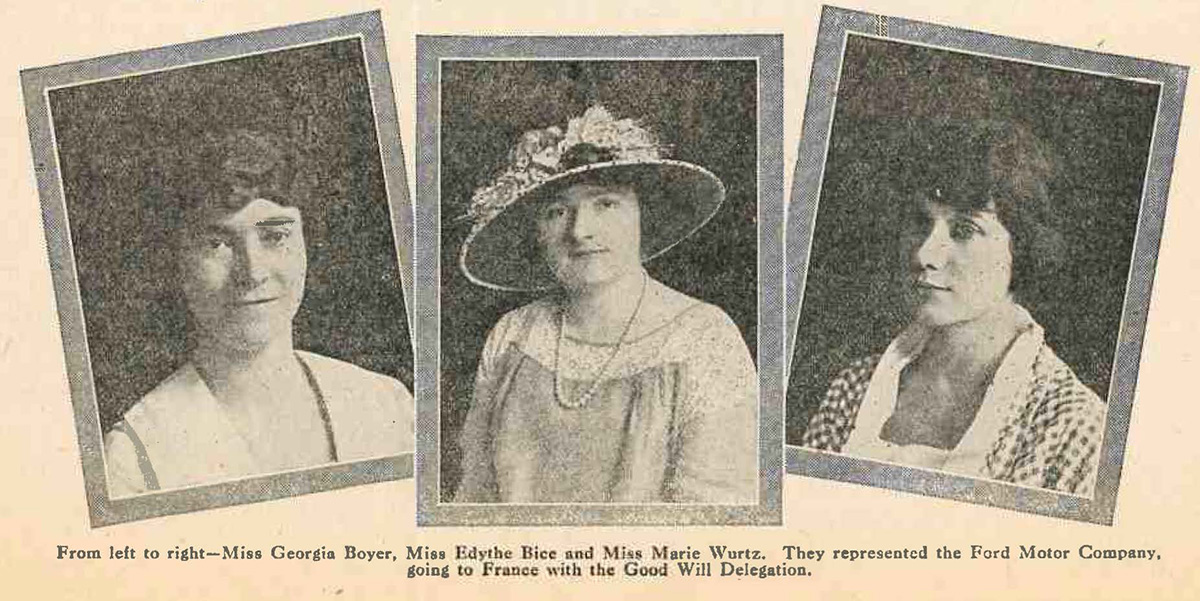
Ford delegates Georgia Boyer, Edythe Bice, and Marie Wurtz. Ford News, October 8, 1922 / Image by Kathy Makas
In 1922, three Ford Motor Company employees were sent to France as part of the American Committee for Devastated France Good Will Delegation Tour to raise awareness of the challenges and needs of the people there. The committee itself was formed during WWI by philanthropist Anne Morgan and physician Anne Murray Dike. Before the war had ended, the committee was soliciting funds and donations and in response, Ford Motor Company sent cars, tractors, and crates of car repair parts to the organization to help relieve war torn France. After the war, while Americans were moving on from the Great War, the committee wanted to remind them that France was still reeling from the years of fighting it had seen. To this end, the Good Will Tour was formed consisting of young female delegates contributing $10,000 each from major American companies. To raise the money, candidates were chosen from within their company by popular vote, with each vote costing $0.10; the only requirements were that they were women engaged in paid work and over 18 years of age.
Ford Motor Company jumped into the fundraising role, placing voting boxes with signs that read "Have you voted today?" in every department and placed publicity in newspapers and special announcements. The company raised enough money to send three delegates, two chosen by popular vote, Edythe Bice and Marie Wurtz, and one as the longest female employee at Ford, Georgia Boyer.
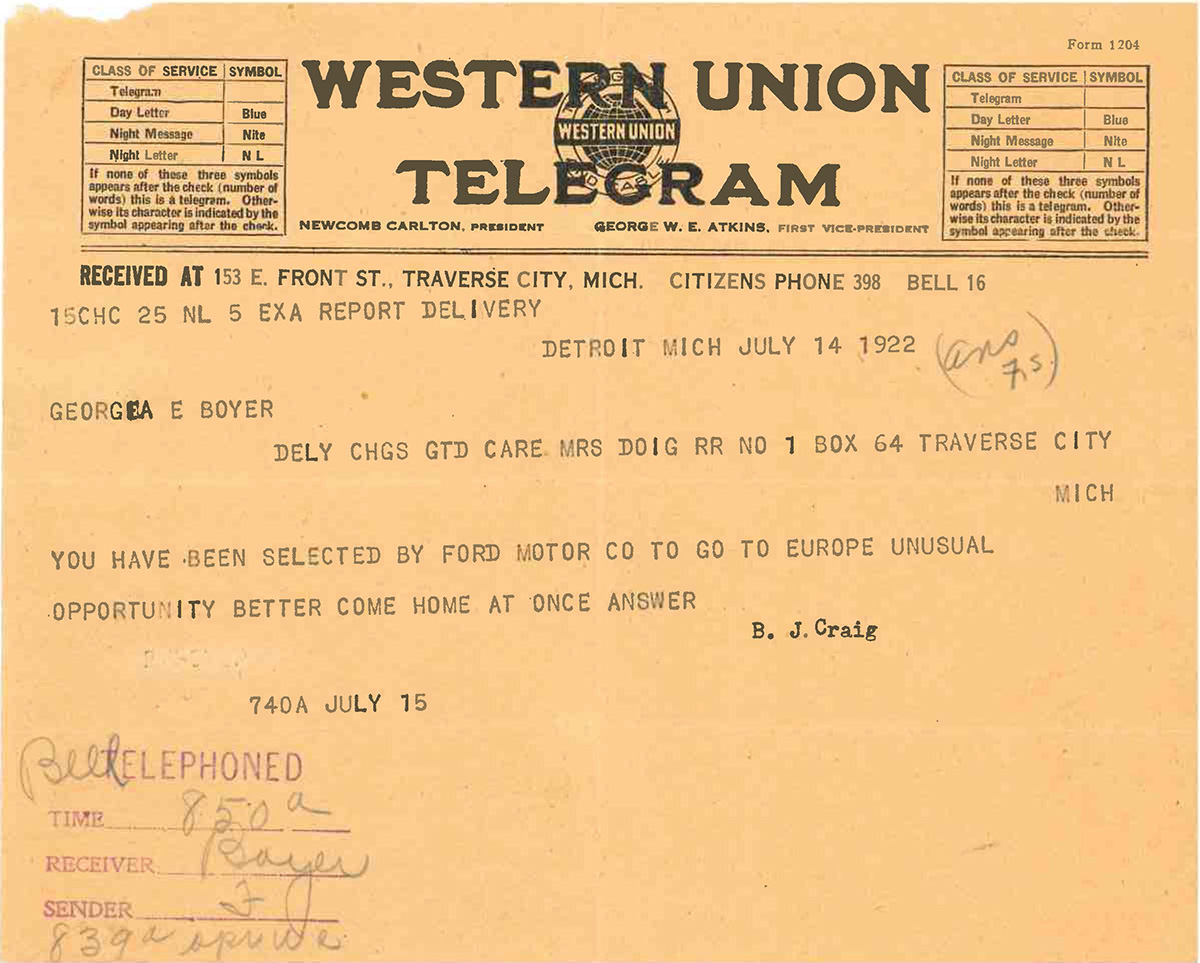
Boyer received word she was chosen while away from work. Acc. 395 / Image by Kathy Makas
On July 26, 1922, the delegation left New York City on the steamer La France for Havre with $500,000 total for committee efforts in France. The tour started in Paris and made its way through the devastated region, traveling through Soissons, Vic-sur-Aisne, Reims, Verdun, and other towns. Boyer noted, "All through this devastated section we saw miles and miles of shell holes, barbed wire, stumps of trees, several dugouts and a few tanks and machine guns which were left by the Germans. Hundreds of buildings, homes and churches were destroyed all through this section, also some beautiful chateaux." But through the work of the committee and other organizations, new buildings and reconstruction were going on all around. The delegation saw the laying of the cornerstone of the Baby Welfare Station and a parade with hundreds of babies marched down the streets in decorated baby carriages. Still, the toll of the war was shocking to the American group. Bice recalled, "As we journeyed towards Verdun it was hard to realize that the war had been over four years. All along the way were shell-torn fields, trenches, dugouts, barbed wire still standing as they were placed, and wire still strung between the trees from which the camouflage screens were hung."

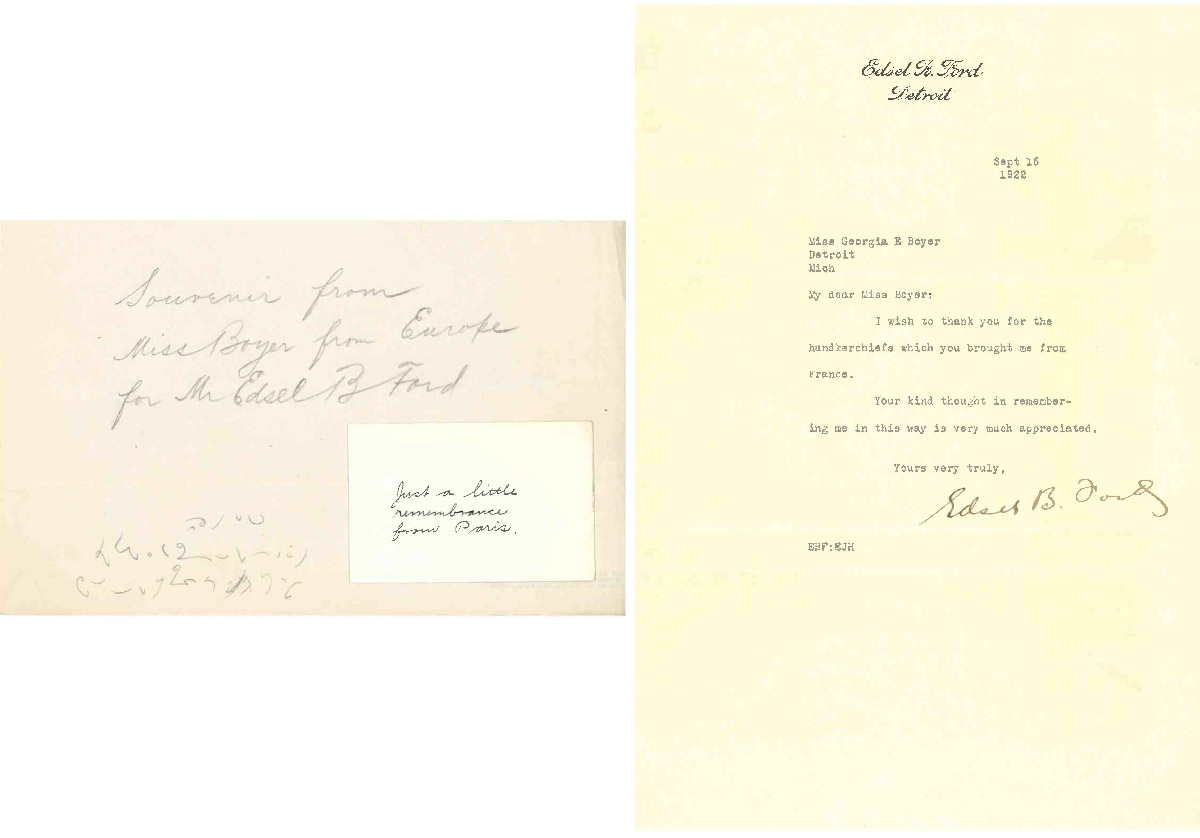
While they were visiting France, Bice and Boyer both wrote to Edsel Ford. Acc. 6 box 5 / Image by Kathy Makas
The delegates made their way back to New York on September 8 bringing with them stories of the destruction, but also of the work that the committee was performing. A series of articles about their time on the tour was published in the Ford News, and Bice presented a talk on Ford's WWI radio station. Bice shared in a Ford News article, the American Committee "is reconstructing not only destroyed material things, but the broken lives and spirits of a great and friendly people. More than that it is making a constructive contribution to the perpetuation of the civilization which 80,000 of our own Americans died to preserve." The committee engaged in work in France for a few more years, before discontinuing in 1924.
Learn more about this and other material in the Benson Ford Research Center.
Kathy Makas is a reference archivist at The Henry Ford.
Playing in Band: Ford Motor Company Employee Bands
Travel, radio fame, snazzy uniforms, and safety rallies. All of this and more were part of life for employee bands at Ford Motor Company.
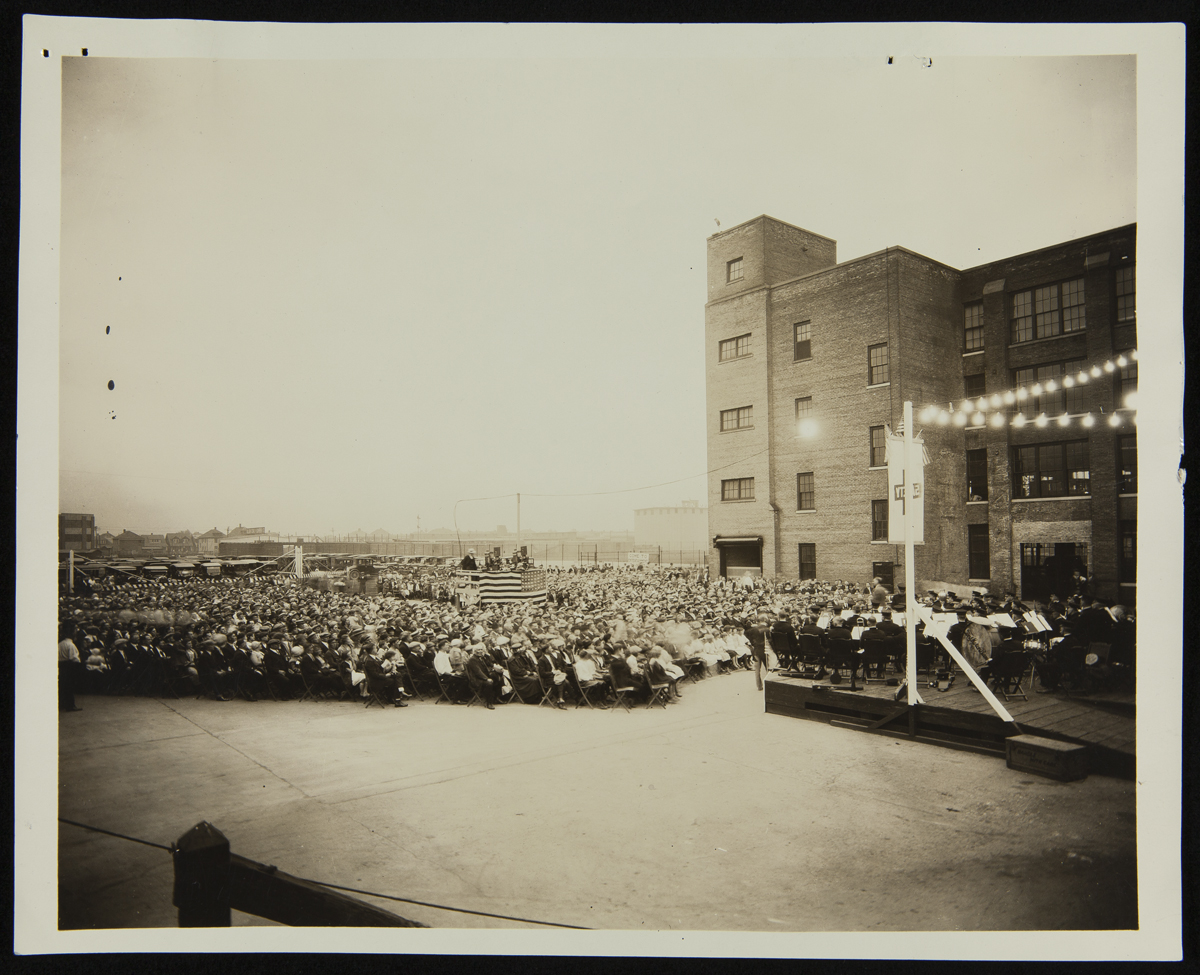
Worker Safety Rally at Lincoln Motor Company Plant, Detroit, Michigan, 1924. / THF261634
The company sponsored a number of employee bands, often hiring musicians into very flexible jobs so they could devote as much time as possible to their music. They played at company events; fairs; on Ford’s radio station, WWI; at competitions; and even traveled on tour. Each band had its own style of music, uniforms, and repertoire. Let’s take a look at some of the bands we have information on in the Ford Motor Company papers which are now part of The Henry Ford’s Benson Ford Research Center archives.
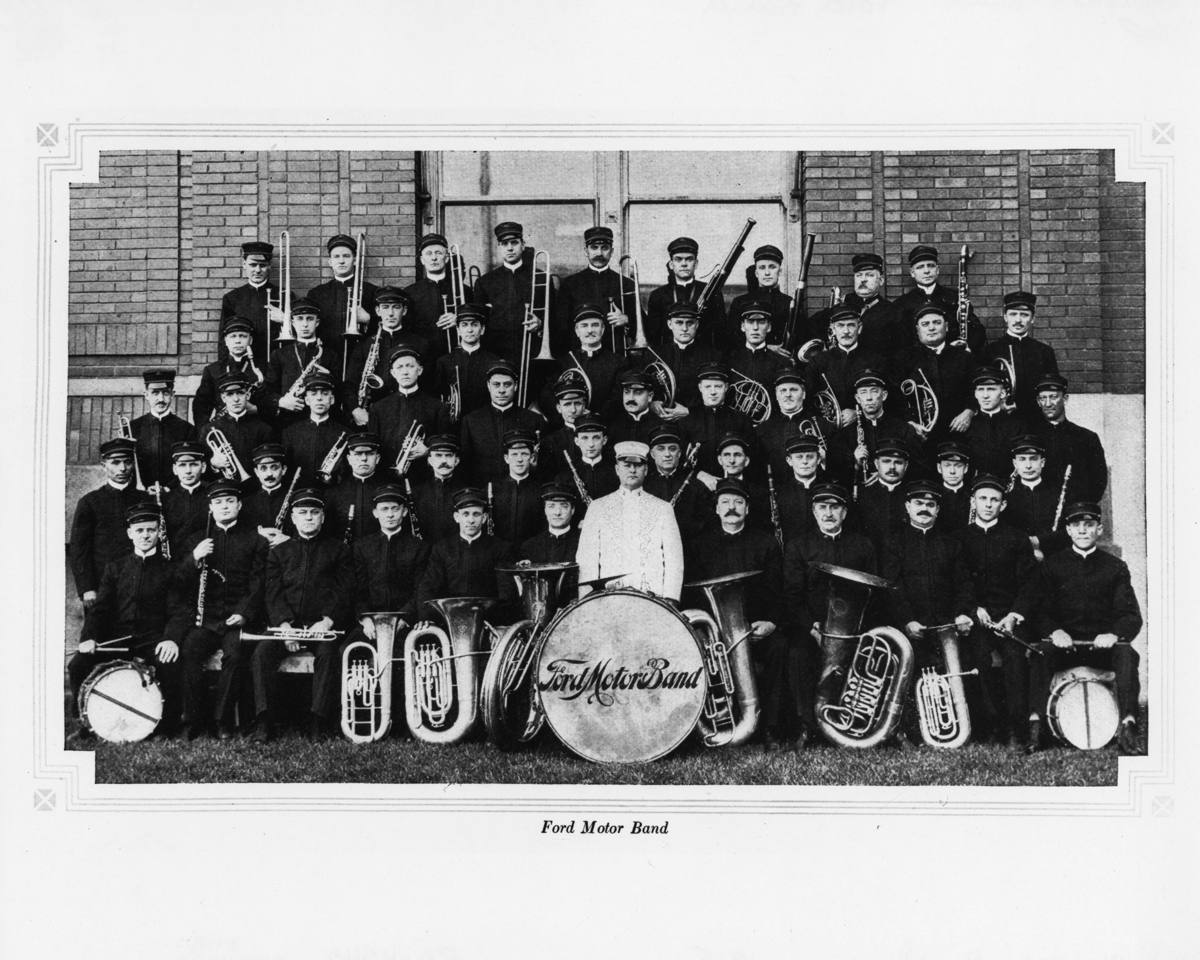
Ford Motor Band. / THF67917
The Ford Band was a marching band formed in the 1910s. They gave their first concert in 1912 at the Administration Building to an audience of 348 and it was all riches and fame from there — well maybe just fame. Led by Harry Philip, the all-employee band averaged between 40-50 musicians. In 1916, they accompanied the East Michigan Pikers on a five-day tour from Detroit to Mackinac Island to promote good roads, travelling in 10 Ford touring cars and playing 21 times a day. They played many company events, gave regular concerts for Ford employees and the public at the Arcadia Auditorium, were a staple at Ford safety rallies, and were often showcased on Ford’s WWI radio station.
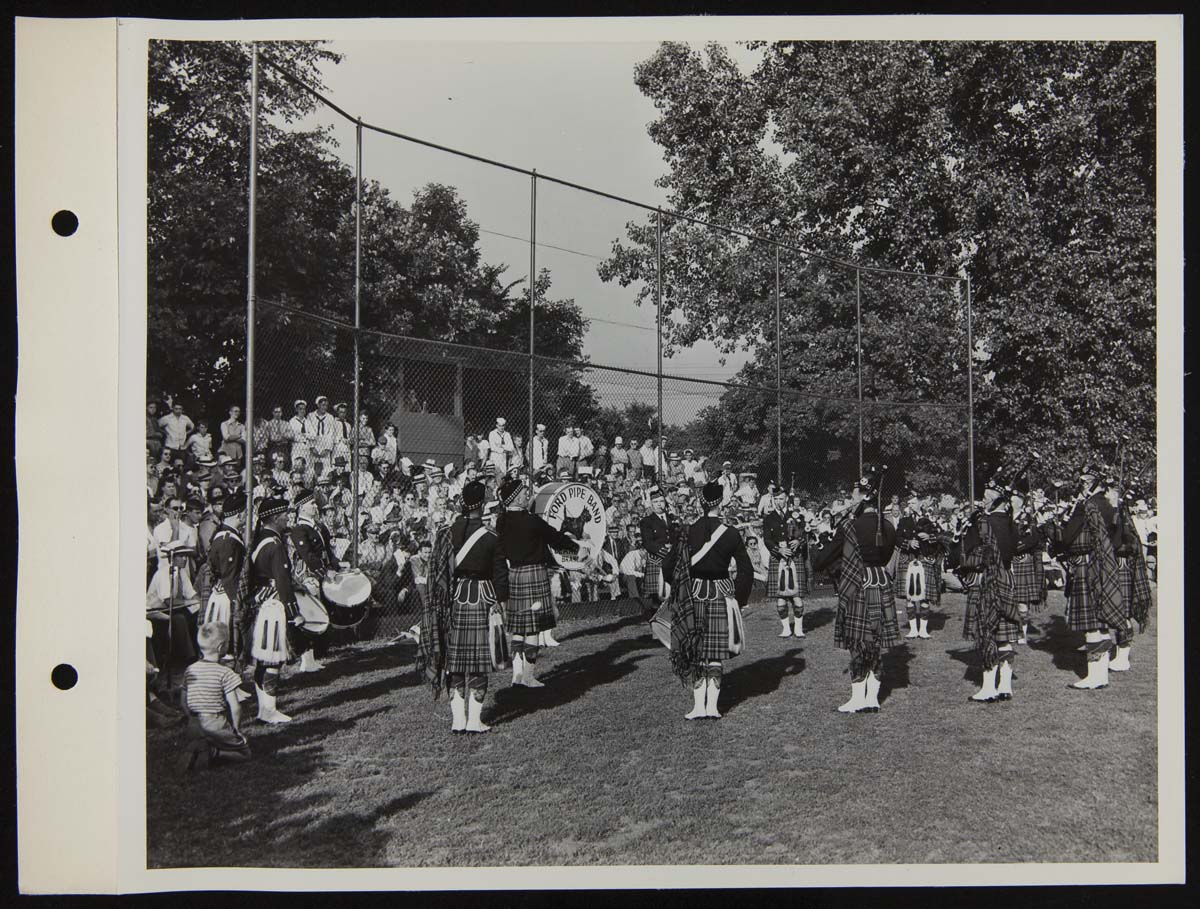
Ford Pipe Band at Ford All-Stars vs. Great Lakes Navy Baseball Game, July 1944 / THF272062
The Ford Pipe Band was formed in 1932 when Alexander Adams, the drum major (who was Edsel Ford’s bodyguard), began recruiting musicians to come work at Ford. The Pipe Major, Hector McInnes, bass drummer, William Riddock, and pipers, James Cullen and Donald McPhee, all worked in Plant Protection, with many of the other members working in departments across the company. Ford sponsored the band and paid for all transportation and lodging, but the band had to pay for their own uniforms. Alec Bryce, one of the drummers, recalled that the band specially ordered their uniforms from Scotland and had them shipped to Ontario, smuggling the uniforms into the U.S. piece by piece to avoid the extra customs fees. The band played at Ford Merit Club meetings, local parades, Scottish games, and other Ford and Lincoln-Mercury events and won both the American and All-Canadian piping championships in 1939.
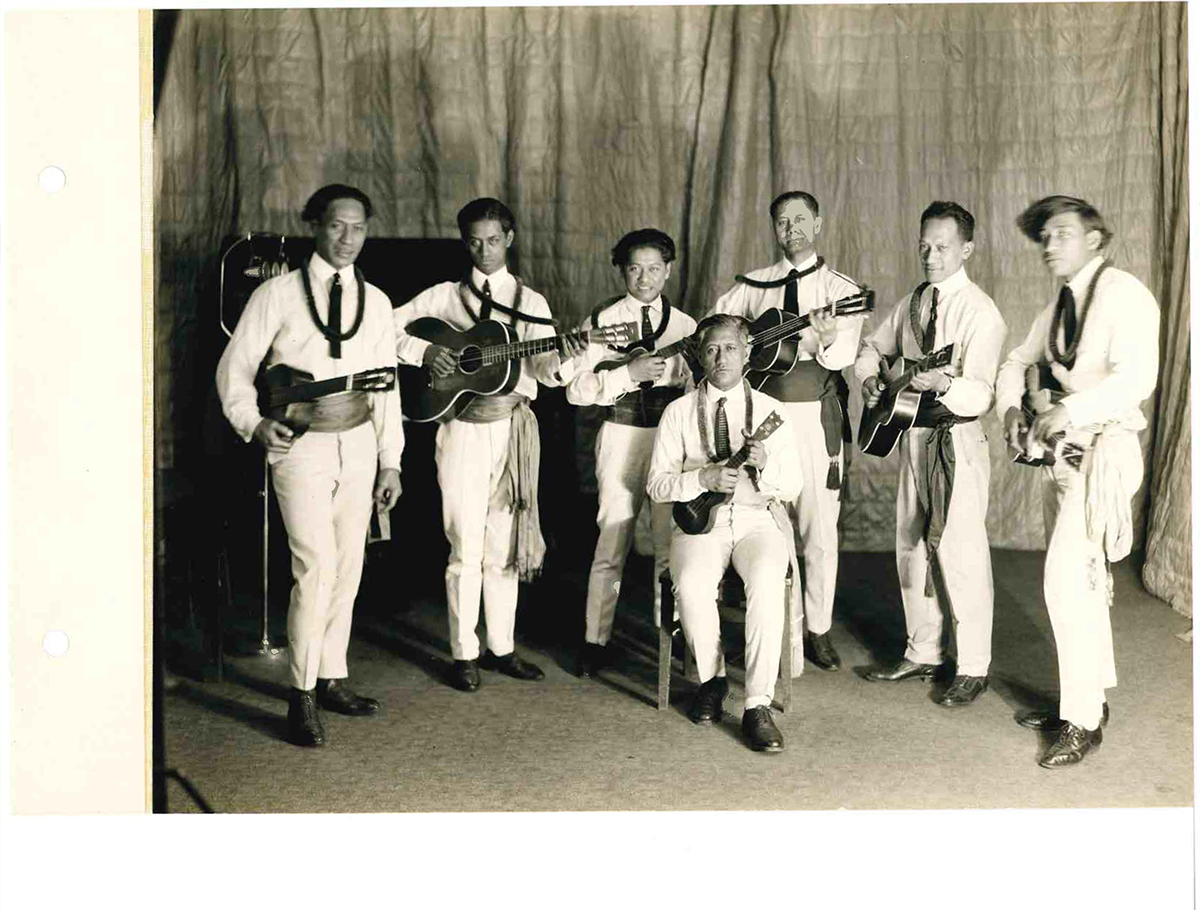
Ford Hawaiians, 1923. Acc.1660 box 146. / Image by Kathy Makas
The Ford Hawaiian Quintet (also known as the Ford Hawaiians) was a ukelele band led by Henry Kailimai. After hearing the band at the 1915 Panama–Pacific International Exposition in San Franscico, Henry Ford signed them up to travel to Detroit for a series of concerts and then a tour of the East Coast.
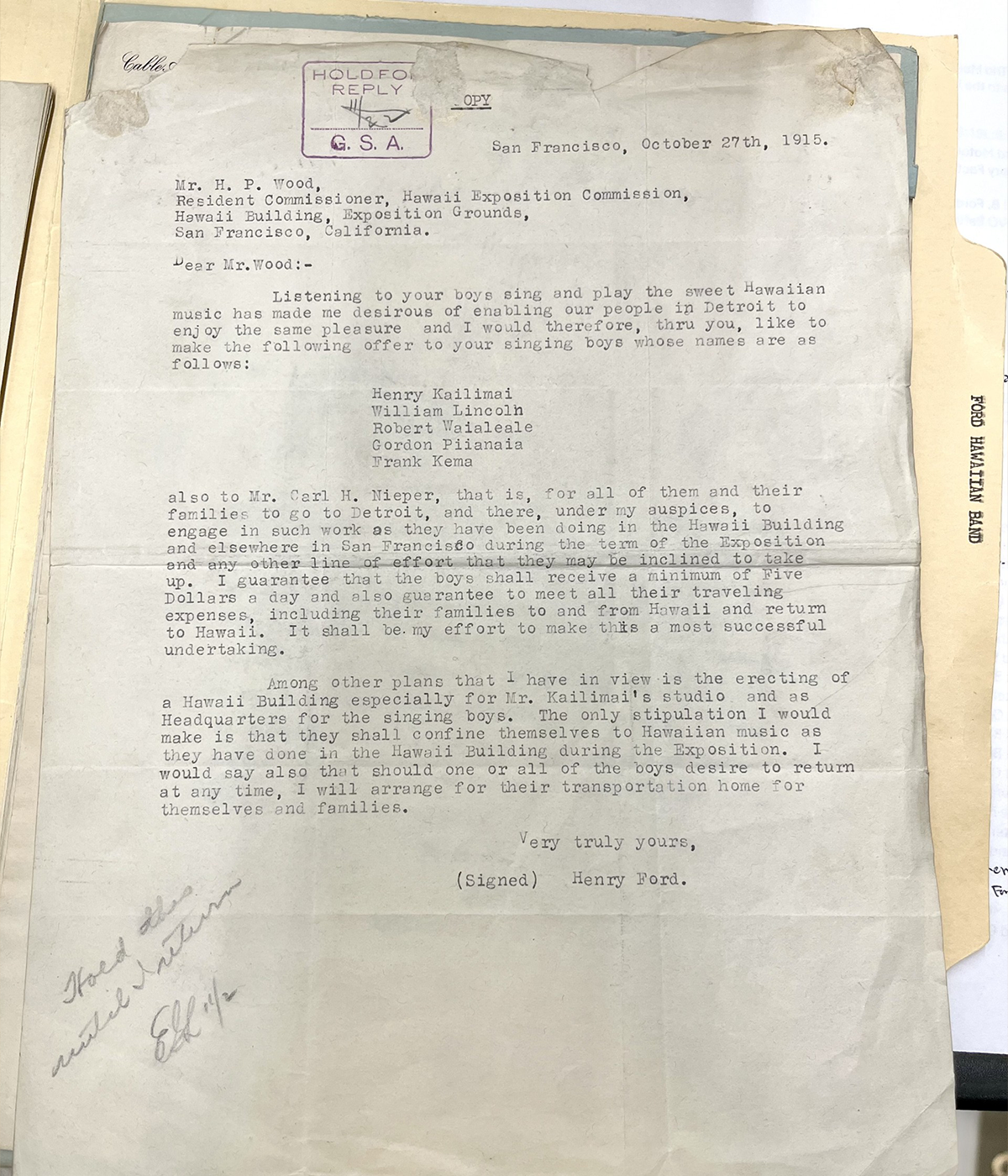
Ford Hawaiian Band. Acc. 62 box 12 / Image by Kathy Makas
Kailimai and the band returned to Detroit with their families, completing a two-year course at the Ford Service School before going to work for the company. After a hiatus in 1917-1918 when several members served in WWI, they continued into the 1920s, even becoming recording artists for one of Thomas Edison’s phonograph companies. The band was up for hire all over the Detroit area playing at concert halls, country clubs, lodges, churches and private events – they even gave ukelele lessons. Some of their hits included “Aloha Oe,” “Moani Ke Ala,” “Lei Poni Moi,” and “Ko Maka Palupalu.” You can hear some of these recordings at the UCSB Cylinder Audio Archive.
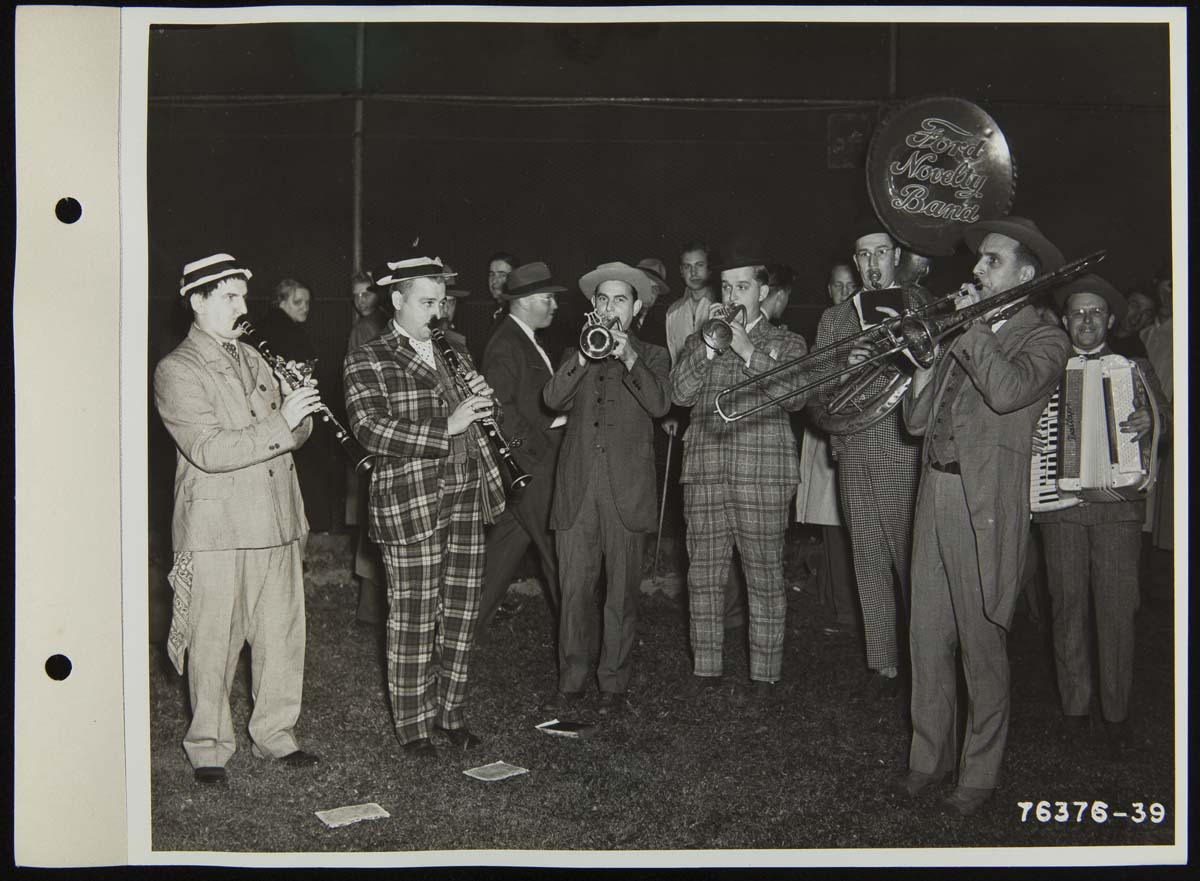
Ford Novelty Band Playing at Ford Baseball Team Game, 1941 / THF271722
The Ford Novelty Band added a comic touch to Ford events, playing at company ball games throughout the 1940s. They played at every game of the 1947 Ford softball playoffs at Levagood Park in Dearborn adding to the value of the $0.25 ticket price fans paid for each game.

Old Timer's Band at B-24 Radio Station Broadcast Studio, Willow Run Bomber Plant, 1944 / THF93762
In addition to the bands we’ve looked at, there were many other employee bands at Ford, including: Ford Trade School German Band, Ford Ramblers, Ford Rube Band, Ford String Ensemble, Ford Glass House Quintet, Ford Motor Company Clarinet Quartet, and Ford Motor Company Saxophone Band. There were also company sponsored bands that weren’t made up of employees like the Ford Orchestra which played on the Ford Sunday Hour and Ford Summer Hour radio programs.
If you have questions about Ford bands, or any other topic in our archive, please email us at research.center@thehenryford.org.
Kathy Makas is a reference archivist at The Henry Ford.
Lincoln’s Century with Ford Motor Company

1928 Lincoln Four-Passenger Coupe Advertising Proof, "Every Lincoln Body is a Custom Creation of Some Master Body Builder" / THF113063
One hundred years ago this month, Henry Ford purchased the Lincoln Motor Company from Henry Leland. The Henry Ford joined in the centennial celebration on our website, where we published a new Popular Research Topic outlining key Lincoln assets from our collections; on Facebook and Twitter, where we shared social posts featuring artifacts from our collections; and on Instagram, where Reference Archivist Kathy Makas shared a Lincoln-related story. Kathy’s story was part of our History Outside the Box monthly series on Instagram, featuring interesting or noteworthy items from our archives.
If you missed the live version of our Instagram story, you can check it out below to learn how Edsel Ford, as president of Lincoln, brought a design eye to the company and how design at Lincoln evolved. You’ll also discover a few of the famous celebrities who owned Lincolns, take a look at some Lincoln publications, and more.
Continue Reading
Ford family, History Outside the Box, Ford Motor Company, Edsel Ford, design, cars, by Kathy Makas, by Ellice Engdahl
Lunch at Ford Motor Company

Women at Lunch Counter, Willow Run Bomber Plant, 1943 / THF114414
Lunch is a part of most people’s workday, but how much do you know about what lunch was like at Ford Motor Company in the first half of the 20th century? Reference Archivist Kathy Makas tackled this topic earlier this month as part of our monthly History Outside the Box series on Instagram. If you missed the Insta story, you can check out the replay below to find out more about the decline of the lunch bucket, the rise of the “sanitary box lunch,” employee cafeterias, and much more, all illustrated with photographs and documents from our archives.
Continue Reading
food, archives, Ford workers, Ford Motor Company, History Outside the Box, by Ellice Engdahl, by Kathy Makas
Celebrity Sightings from Our Archives

Edsel Ford, Charlie Chaplin, and Henry Ford Touring the Ford Motor Company Highland Park Plant, October 1923 / THF134659
Every month, staff from our library and archives select some interesting items from our collections to showcase on The Henry Ford’s Instagram account. In our every-first-Friday History Outside the Box offering, our collections experts share photographs, documents, and other artifacts around a given theme. Last summer, Reference Archivist Kathy Makas showcased some celebrity sightings from our archives—actors, actresses, and other luminaries visiting Ford Motor Company’s factories, World’s Fairs, and The Henry Ford’s own campus; showcasing their cars; and more. If you missed the Insta story, you can check out the presentation below.
Continue Reading
20th century, travel, Michigan, Dearborn, world's fairs, History Outside the Box, Henry Ford Museum, Greenfield Village, Ford Motor Company, cars, by Kathy Makas, by Ellice Engdahl, archives, actors and acting
Out There Having Fun in the Warm California Sun: Aeronutronic Systems
Looking out the window at snowy Michigan probably had any Ford Motor Company engineer, researcher, or scientist thinking that developing and researching space systems, air cushioned vehicles, and computer components in sunny Newport Beach, California, was the way to go.
Aeronutronic Systems, Inc. was formed as a subsidiary of Ford in 1956 under the leadership of G.J. Lynch. The group was originally organized to develop and manufacture products for military purposes in the fields of Complete Weapons Systems, Aeronautics, Electronics, Computers, and Nucleonics and Physics. By 1959, the group was a made a division of Ford and had expanded into research and development beyond military purposes.
Lobby, computer products building. / THF627413
The division was headquartered in Newport Beach, California. Brochures for the division flaunted its cutting-edge research facilities, testing laboratories, research library, and proximity to deep-sea fishing, sailing, skiing, and the fact that the temperature rarely dropped below 44 or rose above 75.
Aeronutronic campus map. / THF627410
The groups within the division worked on a variety of projects. The Space Systems group completed projects including the Blue Scout vehicle, which tested equipment in space; a lunar capsule, designed to land on the moon with scientific testing equipment to gather data on the lunar environment; and a design for a space station.
Group of women who worked on the Blue Scout project. / THF627401
Artist's rendering of lunar capsule built by Ford Motor Company Aeronutronic Division, 1960. / THF141214
Space station concept drawing. / THF627416
In Weapons Systems, they worked on several missile projects, including the Shillelagh Guided Missile for the Army Missile Command, and ARTOC (Army Tactical Operations Central), which was a mobile command post for the Army Signal Corp.
ARTOC command board. / THF627406, detail
The Electronics and Computers division worked on BIAX computer components, as well as MIND (Magnetic Integration Neuron Duplication), an electronic neuron that duplicated the function of live nerve cells, among other things.
Computer elements. / THF627414
Research projects included surface tension tests; developing thin films solid state components; manufacturing the FLIDEN Flight Data Entry Unit, which was used as part of the FAA air traffic control system; and developing an air cushioned vehicle.
FLIDEN unit, demonstrated by Ellen Arthur. / THF627397
Air-cushioned vehicle concept. / THF627420
The employees at the Aeronutronic division had fun too, with an employee newsletter to keep them up to date on company happenings as well as their many recreation leagues, which included bowling, basketball, and baseball among other sports, as well as chess and bridge clubs.
Fred Ju, team captain, bowling in the Men’s Bowling League. / THF627399
Members of the Bridge Club / THF627395
Aeronutronic continued to change with the times. In 1962, it became a division of the Ford subsidiary Philco, and in 1976 became Ford Aerospace and Communication Corporation, before being sold by Ford in 1990.
Kathy Makas is Reference Archivist at The Henry Ford. This post is based on a December 2021 presentation of History Outside the Box on The Henry Ford’s Instagram channel. Follow us there for new presentations on the first Friday of each month.
1960s, California, 20th century, 1950s, technology, space, History Outside the Box, Ford workers, Ford Motor Company, computers, by Kathy Makas, archives

Ford Novelty Band Playing at Ford Baseball Team Game, 1941 / THF271722
Every month, we feature some items from our archives in our History Outside the Box program. You can check the new story out on The Henry Ford’s Instagram account on the first Friday of the month, but we’re reposting some of the stories here on our blog as well. In May 2021, Reference Archivist Kathy Makas shared photographs, articles, and other documents ranging from the 1910s through the 1950s that detail how employees at Ford Motor Company spent their leisure time. Learn more about Ford’s musical groups, sports teams, gardeners, and social/service clubs in the video below.
Continue Reading
Dearborn, Michigan, 20th century, sports, music, History Outside the Box, gardening, Ford workers, Ford Motor Company, by Kathy Makas, by Ellice Engdahl, archives
Knit Along with American Archives Month
It’s American Archives Month and what better way to celebrate than to knit a pattern from our archival collection?
We thought it would be fun to have a knit-along to make some of the patterns from the Priscilla War Work Book: Comforts for Soldiers and Sailors. During World War I, women, men, and children knit garments from this book for soldiers and refugees. Women formed knitting groups, hosted knitting teas and bees, and children knit in school. By the war’s end the Red Cross had received 6.5 million refugee and 24 million military garments made and donated by American knitters.

We’ve included some of the front matter and a few patterns you can choose from to knit. As you can see, the official colors were olive drab, dark blue, and dark gray, however since we’re not knitting for the army or navy, feel free to choose any colors you like. 



We’ve selected a couple patterns for you to choose from or you can knit both!
This Knitted Scarf and Chest Protector (photo is below the pattern, not the one to the left) is a great project for beginners, the gauge and yarn used don’t really matter as you can size this as you like. The scarf was actually made for the Boy Scouts so it is a child’s size, but you can just add more stitches and rows to make it wider and longer if you’d like to make an adult version.

The second pattern is for Thumbless Mittens. These are great because there are two patterns, one to knit flat and one to knit in the round.
A word to those who have not knit vintage patterns: the yarn sizes and needle sizes varied (as you can see in the chart above) and they are not always equivalent to modern sizes so you may need to play with the yarn size and needle size to get the right gauge. Also, to complicate matters, the patterns in this booklet do have a gauge to work off. The thumbless gloves are most likely 6-7 stitches per inch (6 stitches per inch for larger men’s size and closer to 7 stitches per inch for smaller women’s size) knit in sport weight on size 3-5 needles or whatever yarn and needle size needed to get this gauge.
We hope you join us in this Archives Month Knitalong. We’ll have progress posts on Instagram and Twitter where we can all share our project updates and any tips to others working on these.
(All patterns are from Priscilla War Work Book, 2006.0.4.40)
Kathy Makas is a Reference Archivist at The Henry Ford’s Benson Ford Research Center.
World War I, women's history, home life, making, archives, by Kathy Makas
Back to School with the Henry Ford Trade School
As students everywhere settle into a new school year, let’s take a look back at the Henry Ford Trade School, founded in 1916.
The first six boys and three instructors, 1916. / THF626066
The school was formed to give young men aged 12–19 an education in industrial arts and trades. Boys who were orphans, family breadwinners, or from low-income families from the Detroit area were eligible for training and split their time between classroom and shop.
Henry Ford Trade School students and teachers in classroom, October 31, 1919. / THF284497
Students working on machinery at the Rouge Plant, 1935. / THF626060
The school started at the Highland Park plant, expanded to the neighboring St. Francis Orphans Home, and then to the Rouge plant and Camp Legion.
Henry Ford Trade School building, August 1, 1923. / THF284499
Trade School students on campus at the Rouge Plant, 1937. / THF626062
While students were receiving their education, they were also being paid an hourly wage, as well as a savings balance that was available to them at graduation. Students started off repairing tools and equipment, and as they gained more experience, moved on to working on machinery.
Student repairing goggles, Rouge Plant, 1938. / THF626064
Trade School student at the Ford Motor Company Rouge Plant, August 3, 1942. / THF245372
Students also got four weeks of vacation and daily hot lunches.
Students at lunch in the Rouge B Building cafeteria, 1937. / THF626068
The students were trained in a wide range of courses, both shop and academic, using textbooks created by the trade school. Shop courses ranged from welding to foundry work, and academic classes from English to metallurgy.

Shop Theory, 1942: cover and page 149. / THF626070, THF626075
When Ford Motor Company participated in various World’s Fairs, top trade school students were selected to demonstrate their unique style of learning.
Henry Ford Trade School demonstration, California Pacific International Exposition, San Diego, 1935. / THF209775
Students also had time for sports and clubs, including baseball, football, and radio club.
Henry Ford Trade School baseball team and manager, August 1927. / THF284507
Henry Ford Trade School football team, 1923. / THF118176
Claude Harvard with other Radio Club members, Henry Ford Trade School, March 1930. / THF272856
The Henry Ford Trade School closed in 1952. In its 36 years of operation, the school graduated over 8,000 boys from Detroit and the surrounding area. Students graduating from the trade school were offered jobs at Ford but were free to accept jobs elsewhere; among the graduates who later worked for Ford was engineer Claude Harvard (shown above). Other students went on to work in a wide range of endeavors from the automotive industry to arts and design, and even medicine and dentistry.
You can view more artifacts related to Henry Ford Trade School in our Digital Collections, or go more in-depth on our AskUs page. While the reading room at the Benson Ford Research Center remains closed at present for research, if you have any questions, please feel free to email us.
Kathy Makas is Reference Archivist at The Henry Ford. This post is based on a September 2021 presentation of History Outside the Box as a story on The Henry Ford’s Instagram channel.
school, childhood, Michigan, 20th century, sports, making, History Outside the Box, Ford Rouge Factory Complex, education, by Kathy Makas, books, archives
Ford Motor Company Radio and TV Programs
The Henry Ford’s archives contain a great deal of material about radio and television shows produced or sponsored by Henry Ford and Ford Motor Company. Here is just a small sampling of the types of items and shows covered.
Henry Ford began broadcasting over his WWI radio station in 1922. Early broadcasts featured musical acts from company bands, such as the Ford Motor Company Band and the Ford Hungarian Gypsy Orchestra. Later broadcasts expanded the talent pool to acts across the United States, including singers, bands, soloists, and even the California Bird Man.
Ford Motor Company Radio Station WWI, Dearborn, Michigan, February 1924. / THF134739
The Ford Sunday Evening Hour was a popular radio show produced by Ford. This show was broadcast from 1934–1942 (and then again from 1945–1946). The show was performed live in Detroit, first at Orchestra Hall and then at the Masonic Temple, and broadcast over the CBS radio network. Musical pieces were played by 75 members of the Detroit Symphony Orchestra under the name the Ford Symphony Orchestra, with each show featuring guest star soloists and singers.
Ford Sunday Evening Hour program, October 7, 1934. / THF137776
Ford Sunday Evening Hour Dealer Display, 1938. The program was broadcast across the U.S. and was advertised by Ford dealers all over the country. / THF269154
In the summer, the Ford Summer Hour offered lighter, more popular tunes. This program used a smaller 32-piece orchestra and sometimes featured Ford employee bands such as the River Rouge Ramblers and the Champion Pipe Band.
The Ford Summer Hour poster, 1939. / THF111542
Ford Summer Hour program, August 24, 1941. / THF134690
Ford Motor Company sponsored their share of television programs in the 1940s and 1950s as well. The Lincoln-Mercury division sponsored Toast of the Town, later The Ed Sullivan Show. The archives holds this scrapbook of reviews of the first season of the show (or shew) in 1948.

Toast of the Town scrapbook, 1948-1949. / THF622224, THF622504
The 50th anniversary of Ford Motor Company in 1953 was a big celebration. Paintings were commissioned by Norman Rockwell to depict the company history, calendars were assembled, banquets and celebrations were planned worldwide, and the company put together a TV special to celebrate its 50-year history.
Advertisement, "Ford 50th Anniversary Show," June 15, 1953 / THF622247
The TV program featured many well-known performers, many of whom signed Benson Ford’s personal copy of the script.

Script for the Ford Motor Company 50th Anniversary TV Show, Broadcast June 15, 1953 / THF622239, THF622240
These are only a few of the radio and TV shows produced or sponsored by Ford over the years. The archive at the Benson Ford Research Center has additional material, including scripts, ratings, and public relations analysis reports, for several of these shows. Some of these items may be viewed in our Digital Collections, while others have yet to be digitized. While the reading room at the Benson Ford Research Center remains closed at present for research, if you have any questions, please feel free to email us at research.center@thehenryford.org.
Kathy Makas is Reference Archivist at The Henry Ford. This post is based on a February 2021 presentation of History Outside the Box as a story on The Henry Ford’s Instagram channel.
Dearborn, Michigan, Detroit, archives, TV, music, radio, Ford Motor Company, by Kathy Makas, History Outside the Box

